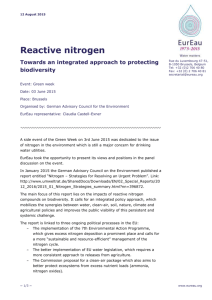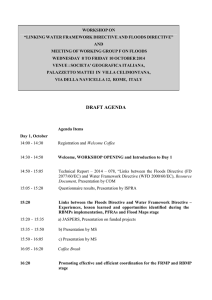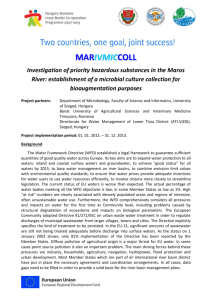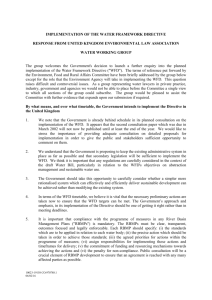THE ECONOMIC REPERCUSSION OF THE WATER FRAMEWORK
advertisement
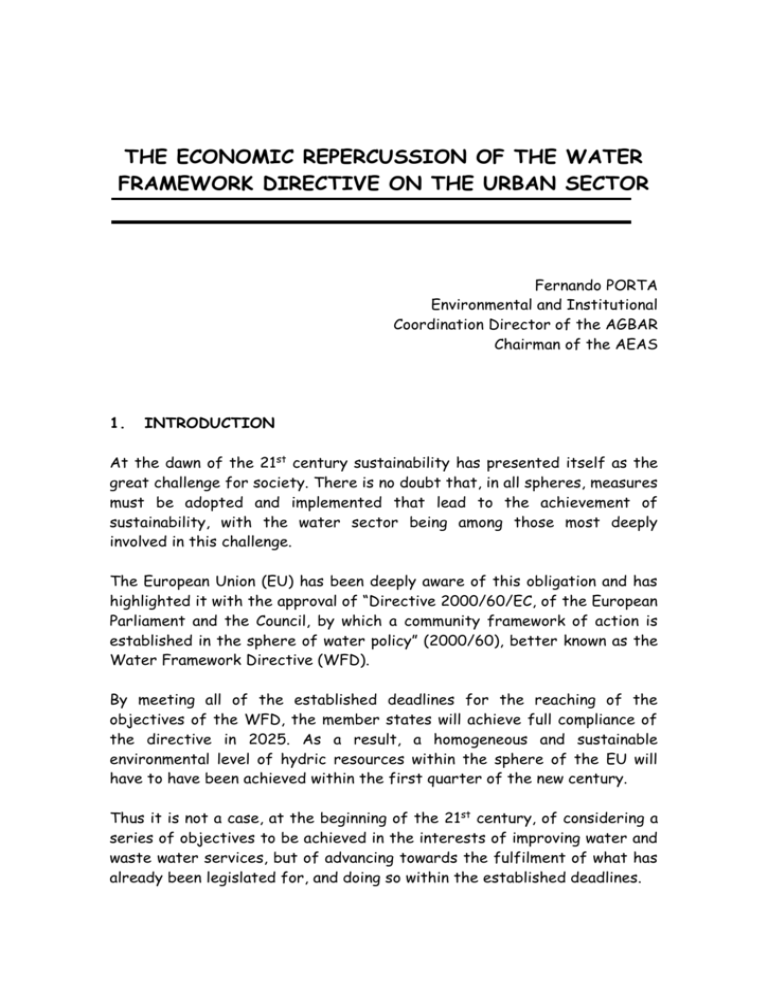
THE ECONOMIC REPERCUSSION OF THE WATER FRAMEWORK DIRECTIVE ON THE URBAN SECTOR Fernando PORTA Environmental and Institutional Coordination Director of the AGBAR Chairman of the AEAS 1. INTRODUCTION At the dawn of the 21st century sustainability has presented itself as the great challenge for society. There is no doubt that, in all spheres, measures must be adopted and implemented that lead to the achievement of sustainability, with the water sector being among those most deeply involved in this challenge. The European Union (EU) has been deeply aware of this obligation and has highlighted it with the approval of “Directive 2000/60/EC, of the European Parliament and the Council, by which a community framework of action is established in the sphere of water policy” (2000/60), better known as the Water Framework Directive (WFD). By meeting all of the established deadlines for the reaching of the objectives of the WFD, the member states will achieve full compliance of the directive in 2025. As a result, a homogeneous and sustainable environmental level of hydric resources within the sphere of the EU will have to have been achieved within the first quarter of the new century. Thus it is not a case, at the beginning of the 21st century, of considering a series of objectives to be achieved in the interests of improving water and waste water services, but of advancing towards the fulfilment of what has already been legislated for, and doing so within the established deadlines. Nevertheless the water sector must also face other obligations. In effect, in the Explanatory Statement of the WFD, the European Council (EC) takes for granted that the Potable Water Directive (98/83), the Nitrates Directive (91/676) and the Urban Wastewaters Directive (91/271) will have to be fully applied, in time and form, when the WFD comes into force. Which member states will be in a position to respond in the affirmative? Furthermore it must also be taken into account that the EC will probably present, in the near future, a Directive Proposal for the regulation of the conditions in which treated wastewaters can be used. Finally, it must also be emphasised that a greater investment in applied research and innovation will have to be made in the European water sector. It is a case of a sector that is capable, in general, of responding to demands for quantity and quality, yet the rates are insufficient to allow for the full recovery of all of the service costs, with the result that investments could be minimised and, should this be the case, investments in research and innovation would be relegated to the back of the queue. It is the question of rates that is of most concern to the water and waste water distribution services, whether such be public or private, due to the large scale increase that the prices of these services will have to undergo if, as is evident, the above directives are to be met. 2. THE IMPRECISION OF ARTICLE 9 OF THE WATER FRAMEWORK DIRECTIVE In order to comment thereon, I partially quote the text of Article 9 of the WFD. “Article 9 Recovery of costs for water services 1. Member States shall take account of the principle of recovery of the costs of water services, including environmental and resource costs, having regard to the economic analysis conducted according to Annex III, and in accordance in particular with the polluter pays principle. Member States shall ensure by 2010 - that the water-pricing policies provide adequate incentives for the users to use water resources efficiently, and thereby contributive to the environmental objectives of this Directive. - an adequate contribution of the different water uses, disaggregated into at least industry, households and agriculture, to the recovery of the costs of water services, based on the economic analysis conducted to the Annex III and taking into account of the polluter pays principle. Member States may in so doing have regard the social, environmental and economic effects of the recovery as well as the geographical and climatic conditions of the region or regions affected. 2. Member States shall report in the river basin management plans on the planned steps towards implementing paragraph 1 which will contribute to achieving the environmental objectives of the Directive and on the contribution made by the various water uses to the recovery of the costs of water services. 3. Nothing in this Article shall prevent the funding of particular preventive or remedial measures on order to achieve the objectives of this Directive. 4. Member States shall not be in breach of this Directive if they decide in accordance with established practices not to apply the provisions of paragraph 1, second sentence, and for that purpose the relevant provisions of paragraph 2, for a given water-use activity, where this does not compromise the purposes and the achievement of the objectives of this Directive. Member States shall report the reasons for not fully applying paragraph 1, second sentence, in the river basin management plans.” Comments 2.2.1. The expression “they will take into account the principle of costs recovery” is not sufficiently explicit, insofar as it is not clearly binding and, furthermore, given that it refers to Appendix III for the preparation of the economic analysis. This Appendix only expounds ideas of a general kind and does not define the items that make up the costs of the services, a necessary chapter in the development of the said analysis. 2.2.2. The environmental costs, as well as those of resources, must be established by the hydraulic administration, for the purpose of adopting the necessary measures in basin hydrological plans for the achievement of the environmental goals. Yet in terms of financial overheads it must essentially be the users, essentially the water and waste water services, that propose their plan of action to the competent administration, insofar as it is the latter that are responsible, for the provision of a service of general interest. Once their opinion is known the administration will then be able to calculate the suitable contribution that corresponds to each water use in the recovery of services costs. 2.2.3. This section is of particular interest, insofar as it allows the member states not to apply costs recovery to a determined water use, always insofar as neither the ends nor the achievement of the goals of the WFD are compromised. In this event, and depending on how the exception is applied, will this not lead to economic and sectoral imbalance? 2.2.4. Other Observations: a) On the other hand, should part of the costs of the large scale infrastructures of general interest forming part of the “registered” supply of water, be included in the price of water? In this respect it must be pointed out that cases, such as the one existing in Spain, have not been taken into account, where the hydraulic regulation of resources is necessary to achieve a sufficient level in supply guarantee. Thus, a costly infrastructure is required that will produce other benefits of a social kind, such as flood protection, the battle against desertification and the maintenance of the population in depressed areas. b) In terms of environmental costs, how can the immense differences between the hydric reality of the north and the south of Europe be combined? c) Meanwhile, the principle that “he who pollutes must pay” may well be difficult to apply. In this case, how can additional treatment costs be claimed from those who cause pollution? 3. THE POSTURE OF THE EUREAU WITH REGARD TO THE WATER FRAMEWORK DIRECTIVE. 3.1 Presentation of the EUREAU The European Union of National Associations of Water Distributors and Waste Water Services (EUREAU) is a non profit Association with the goal, among others, of representing the common interests of its members, public or private, before the institutions of the EU, intervening in the processes of elaboration of community legislation and the European regulations concerning the potable water and waste water sector. The EUREAU is made up of National Associations or Water and Waste Water Services for the 15 European Union member states, as well as Iceland, Norway and Switzerland. There are also 7 observer members, which are the Bulgarian, Estonian, Hungarian, Polish, Rumanian and Croatian associations, as well as the Nicosia Water Service (Cyprus). Thus, today, the EUREAU is the spokesman for the European total water cycle industries, which provide their services to almost 400 million consumers in Europe. It is also a qualified spokesman because, on the basis of the contributions of its members, it can offer an updated body of technical and scientific knowledge, as well as optimum know-how in the water sector 3.2 The EUREAU and the WFD There is no doubt whatsoever that the philosophy of the EUREAU is fully in line with that of the Community Programme for the sustainable development of the environment, in terms of the total water cycle. For the reasons given above the EUREAU backs the decision of the European Commission to draw up a Water Framework Directive Proposal. The EUREAU understood and informed the EC, in its day, that it would have been useful to improve the proposal in three key aspects: practical viability, calendars and priorities, and costs and charges. Insofar as the AEAS (Asociación Española de Abastecimientos de Agua y Saneamiento – Spanish Association of Water Supplies and Waste Water) is a member of the EUREAU, it assumes the position adopted by the latter with regard to the WFD. Judging by the contents of the paper, we will only be dealing with the last aspect. 3.3 Costs and Charges The capacity and desire to pay, along with price equity, are fundamental aspects of reaching the goals of the WFD. There is no doubt that users are increasingly more reticent to meet any increase in the price of water, above all due to a lack of knowledge of costs. Although it is fair to acknowledge the real cost and value of hydric resources it is also necessary to find a balance. The EUREAU believes that this balance can be gained always insofar as the principles of subsidiarity are correctly applied, along with the maxim that “he who pollutes must pay". 3.3.1 Key Terms a) The costs must be equitably assigned among the different sectors affected: domestic, industrial and agricultural. b) In each sector, the principle of subsidiarity will be applied to the allocation of costs. c) Any mechanisms, employed to fix the prices will have to be transparent and must include complete information about subsidies. d) The application of the maxim “He who pollutes must pay” is fundamental. 3.3.2 The EUREAU Proposal In terms of paying for existing services it is believed that it would be of great use to have a clearer idea of the definition of the costs that are produced. From the point of view of the EUREAU, and in order to achieve unification at a community level, the costs of services should be itemised in Appendix III of the WFD, in the following way: a) The financial overheads of services Operating and financing water supply and waste water services Covering all of the operating costs, technical and financial repayments and the compensation of the capital invested. Conservation of resources This refers to the costs resulting from diffuse or discontinuous pollution by agriculture or industry, reservoir maintenance, the impact of transferring water between different watersheds, etc. The costs of pollution should really be paid by the polluter, yet the operational difficulty of the maxim "he who pollutes must pay", has resulted, in some cases, in these costs being included in the service costs. Pollution control Covering the costs of evacuation and reuse of subproducts and sludges, as well as those due to rainwater pollution. Management of hydric resources Covers the administrative costs, and others, of the competent bodies in charge of managing the hydric resources. Billing should be done in conformity with the agreements established in each of the member states. Provision for atmospheric and extraordinary phenomena Should the legislation so allow, an additional cost will be included as a provision for atmospheric and extraordinary phenomena of a cyclical character (floods and droughts), sustained by a suitable technical report. b) Environmental Costs Representing the costs of the damage caused to the environment and ecosystems by the use of the water. This is the question that presents the greatest difficulty. Various attempts have been made, for example, to appraise the intrinsic ecological value of certain aquatic ecosystems, although up to now none have been successful. Research in this sense will have to continue. Environmental costs may, among others, be considered as those due to the maintenance of the ecological flow levels of rivers and in the suitable overall management of surface and subterranean waters in order to palliate, in periods of drought, the scarcity of surface waters. c) Resources costs These are the costs generated by new users due to the exhaustion of resources, beyond the natural process of renewal or recovery (e.g. the over-exploitation of subterranean waters). 3.3.3 Comments a) When establishing prices for their services EUREAU members will continue to reduce costs, improving efficiency and will recommend their customers to use water in a rational way. The EUREAU believes that price incentives are a question of subsidiarity. b) It is necessary to consider the financing of new investments with great care, with a view to achieving the goal of the sustainability of hydric resources, although this aspect is, in particular, a decision that falls with the framework of subsidiarity. When it comes to an evaluation, the member states will have to bear complex issues in mind, such as: 4. Subsidies and social policy. The transparency of the financing process. Investments in long-term, sustainability infrastructures, such as refilling aquifers or large-scale hydric resources projects. OUTLINE OF A TOTAL WATER CYCLE BILL The proposed outline could serve for all of the urban supply and waste water services, managed directly or delegated, either public or private. We distinguish between three items in the total water cycle: potable water, the sewage system, and the treatment and discharge of wastewaters. 4.1 Potable Water Real consumption levels must be billed, measured by meter. Binomial (already introduced in the majority of EU states) and progressive pricing are proposed, differentiating the rates according to type of use: domestic, commercial, industrial, municipal, etc. The service charge must be on the basis of the diameter of the meter that determines the rated flow of the supply, or the type of dwelling. The consumption charge must consist of a maximum of three price increase blocks, in order to penalise high levels of consumption. A method could be established to avoid levies on large families of limited economic resources. In order to rectify these cases, in Barcelona the following exception is applied: as long as it can be justified, on the basis of the municipal census, when five or more people inhabit a dwelling, then the price of the third block is set aside solely for the cubic metres that exceed an individual consumption level in excess of 100 litres per person per day –this being considered a normal average consumption level – i.e., 9 m3 per person per month (36 m3 for a family of four members, this being the limit of the second block). Thus, a family of five members that has consumed 100 m3 in a quarter, will pay the first 18 m3 alt the price of the first block, the following 37m3 at the price of the second block and the remaining 45 m 3 (not 64 m3) at the price of the third block. VAT, even at the reduced rate, will not be applied. The rate must cover financial overheads, i.e. acquisition, transport, potabilisation, health control, storage, distribution and home supply costs, as well as financial repayments, financial charges and compensation of the invested capital. The service charge covers the fixed operating overheads and guarantees immediate availability for users along with permanent access to the service. It depends on the type of supply, which could be from 30% to 40% of the total cost. The consumption charge covers the variable service costs. 4.2 Sewage System Real consumption levels, measured by meter, must be billed. The charge will binominal and progressive, with a maximum of three price increase blocks. Special cases may also be accepted. VAT, even at the reduced rate, will not be applied. The charge must cover the financial overheads of the service and those due to the drainage of rainwater in the case of a unitary sewage system network. 4.3 Treatment and discharge of wastewaters Real consumption levels, measured by meters must be billed, with the differentiation of domestic uses from remaining uses. It must be of an ecological character. For domestic use binomial and progressive pricing are proposed in, at most, three price increase blocks. For other uses it would be advisable to establish a single bracket with two components, general and specific. The general component would have a single value for all uses, while the specific component would depend on the pollutant load of the discharges, in this way applying the maxim that “he who pollutes must pay”. VAT, even at the reduced rate, will not be applied. This rate must cover, not only the financial overheads of the service but also the environmental costs through the specific component. 4.4 The Goals of a Pricing System a) To ensure an equitable share out among users b) To offer a transparent image of the price of the services c) To ensure a balance between service revenues and expenses, in both the short and the long term d) To encourage the rational use of water e) The structure of the rate applied must be: 5. Easy for the user to understand Without difficulties in terms of applying it to the service Stable over time SUSTAINABLE DEVELOPMENT IN HYDRIC RESOURCES POLICY A range of arguments, studied by the EUREAU are proposed, based on the pricing criteria and policy of the European Commission, in order to assist in the achievement of sustainability in waters policy: 5.1 To promote price policies that involve the complete introduction of principles of sustainability (environmental, economic and social sustainability), taking into account the fact that these elements, because of the differences between them, could on occasions enter into conflict and must therefore be balanced. Price policies must have a triple goal: a) To encourage the efficient use of water. b) To provide incentives for a reduction of pollution. c) To guarantee that environmental protection is only carried out after a careful balancing of benefits with costs (not only referring to economic measures). 5.2 To back the principle of total costs recovery and, as a consequence, to attempt to establish, among others, the maxims of “he who consumes must pay” and “he who pollutes must pay”. 5.3 To promote actions the aim of which is to ensure the transparency of cost structures. A greater understanding of why the prices are as they are could result in the more favourable disposition of consumers when they have to pay the water bill. 5.4 Working on the attainment of sensitive models that acknowledge the immense diversity of circumstances in the member states, while bearing in mind the fact that the implementing of the WFD and the ideas expressed therein (e.g. in the notification of the Environment Commission of the European Parliament on pricing, the Fleming report), will lead to a greater unification of cost models and structures among the different member states. 5.5 Encouraging the application of personalised consumption measuring. 5.6 Over the coming years, with the complete recovery of costs and the reduction of subsidies, the tendency will be towards an increase in potable water prices and wastewater management services, that could be significant in some countries, depending on the level of costs recovery. 5.6.1 These increases may affect the capacity of low level income users to pay. The number of customers with payment difficulties could increase proportionally to the prices, even though, at present, they may not represent a significant group. The water bill does not represent an excessive charge in the domestic budget, in the EU, for a middle class family of four, it does not reach 2% of the annual budget. 5.6.2 Opposition to items being included in the water bill that are not related to the water cycle (e.g. waste collection). 5.7 The urban water sector has a social responsibility to provide continuous and high quality potable water supply and wastewater services. Nevertheless, it must not, nor can it, take charge of the billed amount for social classes with minimal economic resources, although it does have the obligation to attend to these users and direct them to the social assistance services that the municipal authorities place at their disposal. One solution would consist of awarding subsidies to the most underprivileged classes, to be paid from general tax revenues, and that such should then be paid to the water service by the social assistance services. Definitively, the price of water must reflect its real cost and cannot be converted into an increase aimed at balancing out social inequalities. 5.8 Cancelling such crossed subsidies as occur, mainly between different uses, and also when especially low rates are collected from one group of consumers, which in turn are compensated by the collection of higher rates from the remaining consumers. Crossed subsidies do not encourage either efficiency or equity and reduce transparency. Given that they can upset the balance of the real cost of the water supply, and that this could mean that consumers are less inclined to save. 5.9 An analysis of water demand is fundamental for this sector, and is a function of the territorial organisation policy. 5.10 It must always be born urban supply service is to of a waste water service the established standards in mind that the maximum priority of the supply water of optimum quality, while that is to discharge water, which complies with into the reception channels. 5.11 To provide campaigns and actions for the education of the population, in order to: 5.11.1 Ensure that they value the product and the services in order to overcome the reticence of users to paying more. In particular to distinguish between the “natural water cycle” and the complex processes required in order to treat water for public consumption, transport it in a safe way and treat it after use. 5.11.2 Help users to understand that the price of water, based on the use of physical units other than cubic metres (e.g. indicating consumption in litres in the bill) or by showing the daily cost equivalent of the billed amount. 6. THE ECONOMIC REPERCUSSION OF THE WATER FRAMEWORK DIRECTIVE ON THE URBAN WATER SECTOR IN SPAIN. 6.1 Average Price of the Total Water Cycle in Spain. According to AEAS data, the average price of the total water cycle in the urban sector in Spain, in 2000, was: € 0.65 per m3 Potable water: Sewage systems: € 0.19 per m3 Treatment: € 0.25 per m3 Average Price: € 1.09 per m3 The average price in 2001 can be determined, approximately, by increasing the previous value by 5%, resulting in: € 1.14 per m3 It must be stressed that 60% of the price of potable water, in respect of the total, will decrease in the future, due to the increase of the percentage for waste water, and due to the significant investments that are going to have to be made in this field (the Urban Wastewaters Directive is only being met at the present time in terms of 65% of the equivalent population). 6.2 Average Cost of the Total Water Cycle in Spain According to a study carried out by the National Institute of Statistics, the average total water cycle cost in Spain, in 1999, was € 1.38 per m3. By increasing this value by 12% we obtain the approximate average cost for 2001, that is € 1.55 per m3. Thus in 2001 the average price was somewhere in the region of 26% lower than the real cost. This is mainly, and undoubtedly, due to the financing of many infrastructures that have not been considered as a direct cost in the total water cycle, but have been allocated to the budgets of the different competent bodies or levied as taxes. 6.3 Economic Repercussion of the WFD In order to implement the WFD it will previously be necessary to comply with the Potable Water Directive (98/83), the Nitrates Directive (91/676) and the Urban Wastewaters Directive (91/271), such being taken for granted in the Explanatory Statement of the WFD Proposal. In terms of Directive 91/676 there is no estimation of its cost, given that it would be impossible, in the medium term, to decontaminate the subterranean waters, which means that the technical and economic viability of other solutions will have to be studied. The cost of the investments necessary to comply with the above-mentioned directives and the WFD will be very high. An unofficial figure that has been estimated, for the urban water sector, is € 645 per inhabitant. 6.4 Increase of the Average Price If we assume that the resulting amount, including the costs of the overall supply services and waste water infrastructure can be spread over the next 20 years, then the average price would be 30% up on the present figure. Nevertheless, the fact that the price of the total water cycle is around 0.9% of the annual budget of a middle class family of four people, then the application of the resulting increase can be seen as feasible. Should such not be met, then the sustainability of hydric resources in Spain, within the forecast term, cannot be achieved. Thus it will either be necessary to defray the investment through taxation, which is an indirect and inequitable method given that the whole population pays, whether or not they are users of the services for which charges are being collected for the infrastructures being built. 7. CONCLUSIONS 7.1 Complete potable water supply and waste water services costs recovery will be a basic factor in the achievement of a sustainable waters policy. Nevertheless, we will previously come up against a significant barrier: i.e. the reticence of users to the increase in the price of a service that, today, in most of the EU member states are billed at a value that is lower than the real cost. In effect, the present and future financial needs that arise from this will be very high. 7.2 An awareness must be developed in users with regard to the breakdown of the price of water and this can only be achieved by government information campaigns. Users must know that costs have a repercussion on the price of water, i.e. financial overheads, environmental costs and the costs of resources. 7.3 The application of subsidies is an easy solution, but is not equitable, as it is generated from taxes that are levied on the population as a whole, whether or not they are users of the service. The application of specific rates or fees or self-financing is more logical, yet the equity of these systems is also questionable, as they benefit future users. An equitable financing would be obtained by means of loans or the provision of capital, given that both present and future users would then participate in the recovery of the cost. 7.4 It would be advisable to achieve unification at a community wide level of the different types of costs. Efforts must also be made to avoid the billing for the service being used as a tool to include certain taxes that are not, in fact, related to the water cycle. 7.4 The price of water must reflect real costs and cannot be converted into an increase aimed solely at balancing out sectoral inequalities. 7.5 The cost of water consumption for a middle class family of four in the EU is less than 2% of their annual budget. This allows for a margin in which to increase prices for potable water supply and waste water services. Barcelona, March 2002
